For five years, I'd been living in Madrid, happily absorbed in the whirl of big-city life. The city was magnetic—the history hidden behind every street corner, the late nights that spilled into early mornings, and the rhythm of life that only a major metro center can offer. I thrived on the hustle and bustle.
Then came the pandemic… and Madrid's energy vanished. Like the rest of Spain, Madrid faced strict restrictions, and I could only leave my apartment for essential trips to the grocery store. For three months, my world shrank to the walls of my small apartment in the city center. Even when the lockdown was lifted, travel outside the Madrid region was banned for several more months, making the city—once so expansive—feel stifling.
Get Your Free Spain Report Today!
Get Your Free Spain Report Today!
Learn more about the lower cost of living in Spain and other countries in our free daily postcard e-letter. Simply enter your email address below and we'll also send you a FREE REPORT — Live the Good Life in Sunny, Affordable Spain.

By submitting your email address, you will receive a free subscription to IL Postcards, Overseas Dream Home, The Untourist Daily and special offers from International Living and our affiliates. You can unsubscribe at any time, and we encourage you to read more about our Privacy Policy.
As restrictions eased, many of my friends moved to the coast, seeking more space for less money. They gravitated toward places like Valencia on the east coast, and Malaga on the south coast. I'd never considered moving to the coast, but with winter looming, I found myself thinking about it more. Winters in Madrid are mild, but for this native Houstonian, they're long enough to crave an escape. So I planned a six-month coastal retreat, with the intention of returning to Madrid in the summer.
I headed to Malaga in November 2020, just before Spain tightened travel restrictions between regions again. I'll never forget my first day in Malaga, sitting on the beach with my trusty sidekick Chihuahua. I'd left Madrid bundled up in a coat, and suddenly there I was, basking in the sun in a bikini. It was a marvelous contrast from the life I'd just left behind.
There's more to discover than just sunny shores here. With a history as a Moorish territory from the 700s until its Christian conquest in the 1400s, Malaga boasts layers of culture and heritage. It's become Spain's fastest-growing region, earning recognition from Forbes in 2023 as the best city in the world to live and work, and celebrated by International Living as one of its top 20 retirement regions for 2025. What was supposed to be a six-month stay in Malaga turned into four years, and I've had the privilege of exploring beyond the city itself…
Malaga, the name of the city and its surrounding province, offers a blend of history, nature, and coastal charm. Just a quick three-hour train ride from Madrid, the sun-soaked region is bordered by the Mediterranean Sea to the south, and surrounded by the provinces of Cadiz, Seville, Cordoba, and Granada. While Malaga city itself may not rival the beauty of nearby Seville or Granada, its true magic lies beyond its city limits.
The province is part of Andalusia, a region that embodies the classic stereotypes of Spain—siestas, flamenco, bullfighting, and warm, jovial people. Malaga's Costa del Sol, (‘Sun Coast'), lives up to its name, with its sunny skies and Mediterranean lifestyle.
I've explored Malaga province in depth, and I've discovered a place brimming with diversity. Malaga's coastline is dotted with picturesque fishing villages. Go inland and see white-washed towns nestled in the mountains. Retreats above the hilltops offer a tranquil escape from the buzzing port towns.
Get Your Free Spain Report Today!
Get Your Free Spain Report Today!
Learn more about the lower cost of living in Spain and other countries in our free daily postcard e-letter. Simply enter your email address below and we'll also send you a FREE REPORT — Live the Good Life in Sunny, Affordable Spain.

By submitting your email address, you will receive a free subscription to IL Postcards, Overseas Dream Home, The Untourist Daily and special offers from International Living and our affiliates. You can unsubscribe at any time, and we encourage you to read more about our Privacy Policy.
In this guide, we'll embark on a journey through Malaga Province… where there's something for everyone. We'll start in Malaga city, where ancient history meets modern life. Then, we'll venture east to Nerja, known for its dramatic cliffs, before continuing to Frigiliana, one of Spain's most captivating rustic villages.
Next, we'll head west to Mijas, a town perched in the mountains. From there, it's on to Marbella, a place where tradition and luxury collide. Our itinerary wouldn't be complete without a stop in Estepona, a coastal town with a laid-back atmosphere.
We'll also visit the hidden gem of Genalguacil, a tiny mountain village known for its incredible natural beauty. Afterwards, we'll arrive at Ronda, a breathtaking town with an iconic bridge. We'll cap off our adventure at the Caminito del Rey, a walk along a suspended pathway high above a gorge.
Malaga City: Culture, Churros, and the Coast
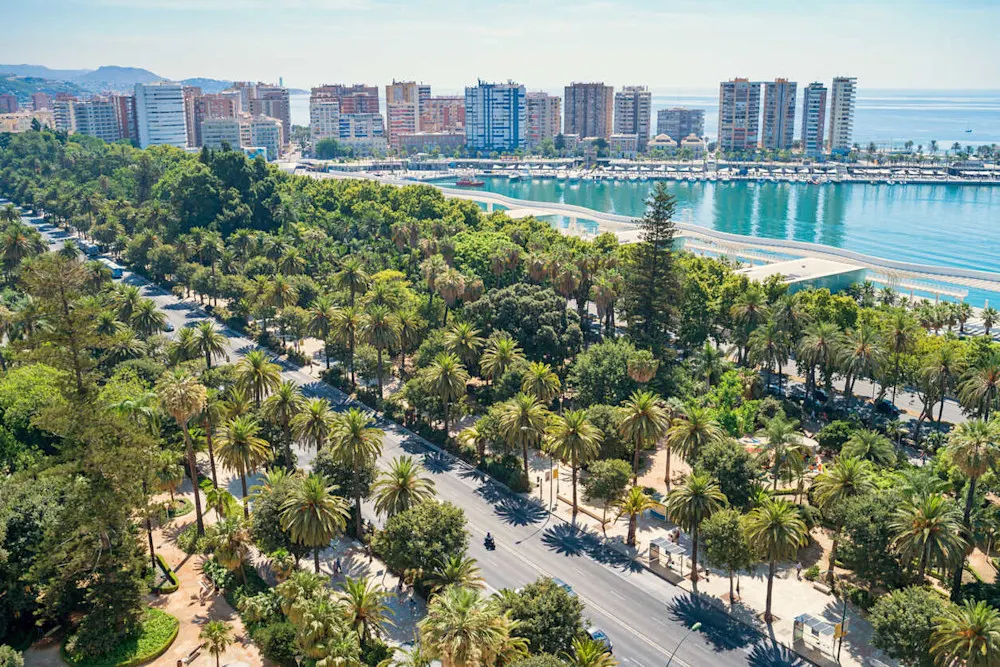
Malaga city, once merely a gateway for visitors to nearby coastal towns, has transformed into a destination in its own right, emerging as a culture capital with prominent museums and vibrant street art.
As one of the oldest continuously-inhabited cities in Western Europe, Malaga boasts a lineage spanning nearly 3,000 years and has witnessed various rulers, from the Phoenicians to the Moors and Christians. It is also the birthplace of icons like Picasso and Antonio Banderas.
Despite the influx of expats, the city retains its genuine charm, with friendly and hardworking locals known as Malagueños.
Morning: Start Local with Churros and Picasso
Begin your morning like a true Malagueño at Casa Aranda, a legendary spot for churros and chocolate. Most tourists are used to the thinner, crispy version of churros, but here you'll be served porras—a thicker style of churro that's just as delicious when dipped in velvety chocolate. Casa Aranda has been serving churros since 1932, and it's a popular favorite among locals.
After fueling up, head to the Picasso Museum. Get there early, because the lines can get long. Picasso was born in Malaga, and the museum, housed in the Buenavista Palace, is a spectacular place to explore his legacy. The 16th-century palace is a work of art itself, and hosts over 250 pieces of Picasso's work.
Afternoon: A Coastal Escape to Pedregalejo and El Palo
As the day heats up–average highs in the summer can reach 90°F–head east to the historic fishing neighborhoods of Pedregalejo and El Palo. When I first moved to Malaga, I lived in El Palo, and it was a world away from the fast pace of Madrid. The beach was three blocks from my door and everyone knew each other, from the local doctor to the neighborhood baker.
From Pedregalejo, stroll along the beachfront promenade. The beaches here are perfect for a dip in the Mediterranean. After soaking up some sun, it's time for seafood. Restaurante Antonio is a personal favorite of mine, but if you're up for something unique, try El Tintero, where the waiters walk around with platters of seafood, shouting out the names of the dishes and placing them down once they see a hand raised or hear someone shout "Sí, por favor!". It's chaotic in the best way.
When you order your seafood, don't be surprised if the grilled fish arrives whole—bones, eyes, and all. Shrimp comes with shells, heads, and little legs. This is as fresh and authentic as it gets. Try the espetos (sardines grilled on a wood-fired boat), pescaíto frito (fried fish), and pipirrana malagueña, a local salad with tomatoes, peppers, onions, and mussels, clams, or prawns. Instead of sangria, do as the locals do and order a tinto de verano, which is red wine with lemon or orange flavored soda water. It's refreshing and not too sweet.
Get Your Free Spain Report Today!
Get Your Free Spain Report Today!
Learn more about the lower cost of living in Spain and other countries in our free daily postcard e-letter. Simply enter your email address below and we'll also send you a FREE REPORT — Live the Good Life in Sunny, Affordable Spain.

By submitting your email address, you will receive a free subscription to IL Postcards, Overseas Dream Home, The Untourist Daily and special offers from International Living and our affiliates. You can unsubscribe at any time, and we encourage you to read more about our Privacy Policy.
After a big lunch, take a Spanish siesta. Not everyone in Malaga takes the midday nap, but it's a common practice in the summer when the heat can be intense. Why not embrace it with a full stomach?
Evening: Flamenco and Sherry to End the Day
As the evening cools down, immerse yourself in another essential Andalusian experience: Flamenco. Alegría Flamenco puts on an incredible show, where the passion and intensity of the dance come to life. Prepare to be mesmerized by the rhythmic clapping, stomping, and soulful guitar.
Before calling it a night, stop by Antigua Casa de Guardia for a glass of local sherry. This cozy bar is one of the oldest in Malaga, with barrels lining the walls and bartenders pouring straight from the tap.
Heading East: Nerja and Frigiliana
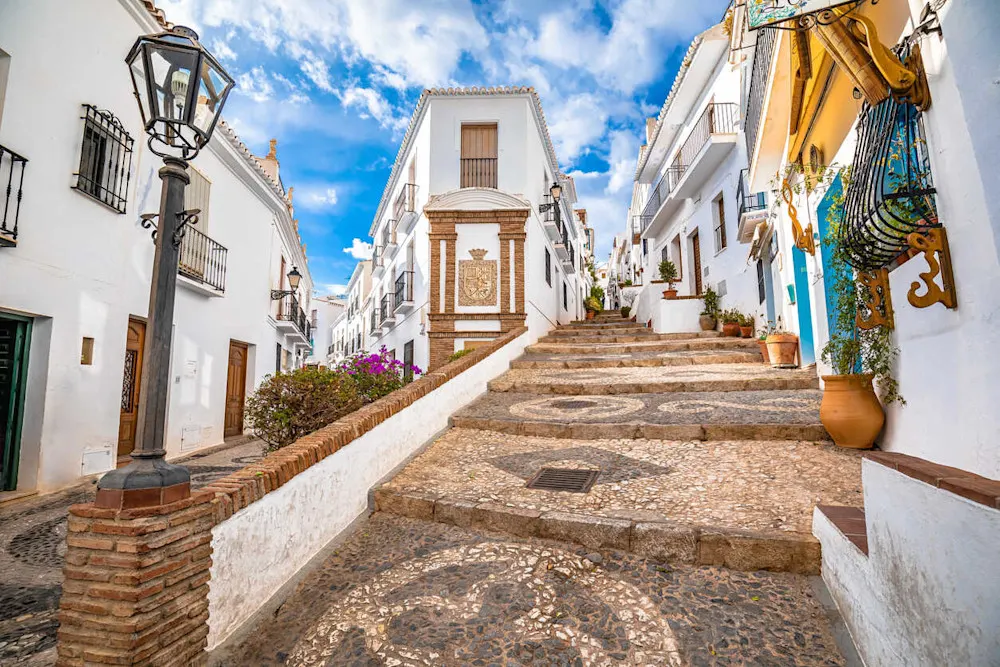
It's time to leave the capital and head east to the quaint seaside town of Nerja, just a 50-minute drive from Malaga. You'll spend two nights here, with one day dedicated to exploring Nerja and the next venturing to the nearby mountain village of Frigiliana.
Nerja: Caves, Sun-Drenched Beaches, and Spanish Wine
Check into the Hotel Balcón de Europa and ask for a seaview room with a balcony overlooking the Mediterranean. The central location, unbeatable views, and attentive hospitality make it a smart choice for your stay.
Stroll along the main pedestrian street, lined with traditional houses, tapas bars, and shops, while soaking in Nerja's cute and historic charm. Be sure to wander into landmarks like the 17th-century El Salvador Church and the La Ermita de Nuestra Señora de las Angustias Hermitage Church.
Book your tickets in advance for the Cueva de Nerja, an expansive cave system just 10 minutes from the town center by car. These caves, nearly 2.5 miles long, offer a glimpse into prehistoric times, with evidence of human habitation dating back to 25,000 BC. While only a portion of the cave is open to the public, you'll see the world's largest stalagmite and learn about the mysterious cave paintings thought to be from the Neanderthal era.
After, relax at the hotel's private beach or visit Playa de la Calahonda, nestled between two towering cliffs, one with a fisherman's house built directly into the cliff. In the evening, enjoy dinner at Copa Vino, known for its inviting ambiance, excellent Spanish wine selection, and hearty dishes from Spanish beef cheeks or oxtail to Italian pastas.
Frigiliana: A Walk Through Time (And White Walls)
Nestled in the hills above Nerja, Frigiliana is one of Andalusia's most beautiful white-washed mountain villages, or pueblos blancos. It's a quick 15 minute drive up the mountain, or for the adventurous, it's possible to hike to Frigiliana and back to Nejra along five different trails.
Start your day by strolling through the picturesque streets of Frigiliana's barrio alto, or barribarto as the locals call it, the oldest part of the village, where cobbled paths meet the white building walls, and flower displays create a charming atmosphere. The best way to explore Frigiliana is to wander, as each narrow street and hidden square reveals a new view or a beautifully adorned doorway. As you explore, be sure to follow signs to the miradors (lookout points), such as Mirador Panorámica Frigiliana and Plaza de las Tres Culturas, which offer panoramic views of the village and the Mediterranean.
Get Your Free Spain Report Today!
Get Your Free Spain Report Today!
Learn more about the lower cost of living in Spain and other countries in our free daily postcard e-letter. Simply enter your email address below and we'll also send you a FREE REPORT — Live the Good Life in Sunny, Affordable Spain.

By submitting your email address, you will receive a free subscription to IL Postcards, Overseas Dream Home, The Untourist Daily and special offers from International Living and our affiliates. You can unsubscribe at any time, and we encourage you to read more about our Privacy Policy.
For a deeper understanding of the village's history, consider joining a daily 1.5-hour guided walking tour available for Spanish speakers–no English speaking tour available. You'll learn about Frigiliana's significance during the Reconquista, and the blend of Christian, Jewish, and Muslim cultures that shape its heritage today, highlighted by the annual Festival of the Three Cultures in August.
If you happen to visit on a Thursday, head to the weekly Frigiliana Market. Held in the heart of the village, the market features stalls selling everything from leather goods and local crafts to fresh produce and sweets. It's a great place to pick up unique souvenirs while soaking in the lively atmosphere.
For lunch, choose between two excellent options: Restaurante El Jardín or Restaurante El Mirador-Frigiliana . Both offer incredible views, but if you're looking for a more authentic Andalusian experience, head to El Mirador. Their Iberian pork cheeks are a local favorite. Whichever spot you choose, be sure to order a glass of Barbadillo, a popular white wine from Andalusia.
After lunch, continue your exploration by visiting El Ingenio, or the Sugar Mill. This 16th-century Renaissance-style palace once belonged to the Manrique de Lara family and is the last remaining sugar cane honey factory in Europe.
Mijas: A Picturesque Piece of Costa del Sol
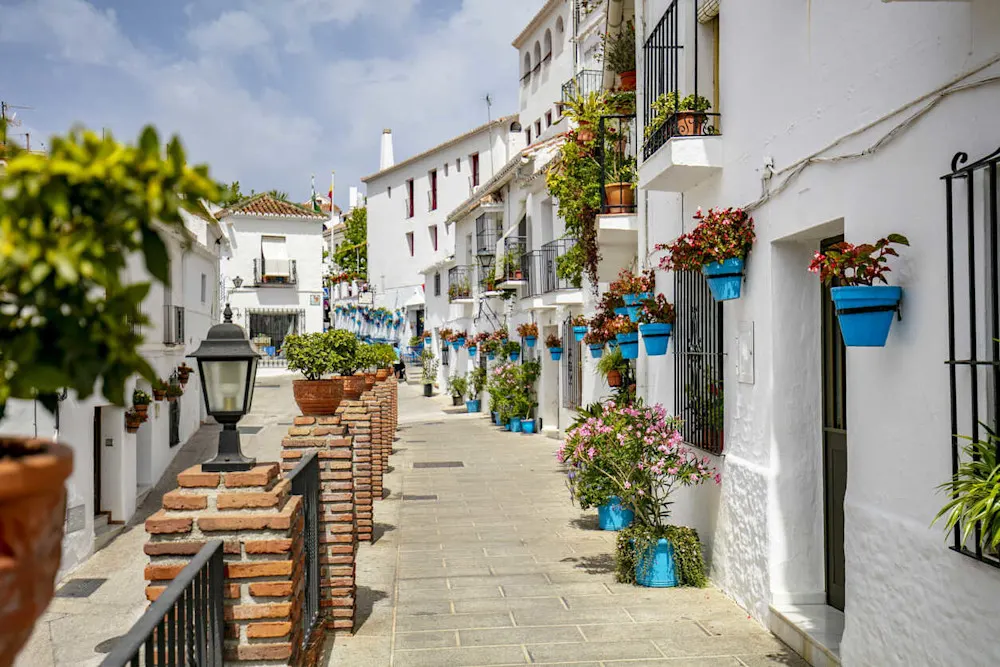
Mijas is another iconic pueblo blanco in Andalusia. Located just over an hour from Nerja, this tranquil village is perfect for a day of exploring. I hosted a retreat here in 2023, and its atmosphere provided an ideal setting to fully relax. Although the town is famous for its donkey taxis, I wouldn't recommend taking one. Donkey taxis in Mijas Pueblo are primarily used for entertainment. Animals used for entertainment are often subjected to stress, isolation, substandard care. It's common to see them tied up in the heat for hours on end with limited access to water; these animals deserve better. If you'd like to interact with donkeys, consider visiting Donkey Dreamland, a donkey sanctuary in Mijas, where you can enjoy these gentle creatures in a caring environment that prioritizes their well-being.
Morning: Start the Day Slow in the Streets
Start your day at Aroma Café & Secret Garden, a lush oasis where you can enjoy a coffee and bite to eat. The calm atmosphere here is a great introduction to the laid-back vibe of Mijas.
From there, take a stroll through the heart of the village. Plaza de la Constitución is a lovely starting point, featuring a quaint fountain and benches crafted from stones salvaged from homes destroyed during a devastating flood in 1884. This square is not only beautiful, but also a testament to the resilience of the town.
Make your way to La Ermita de la Virgen de la Peña, or the Chapel of the Virgin Mary of the Rock. Legend has it that two children were guided to the site by a white dove where the Virgin Mary appeared. The chapel, carved into the rock by a Carmelite monk, is one of Mijas' most significant religious sites.
Get Your Free Spain Report Today!
Get Your Free Spain Report Today!
Learn more about the lower cost of living in Spain and other countries in our free daily postcard e-letter. Simply enter your email address below and we'll also send you a FREE REPORT — Live the Good Life in Sunny, Affordable Spain.

By submitting your email address, you will receive a free subscription to IL Postcards, Overseas Dream Home, The Untourist Daily and special offers from International Living and our affiliates. You can unsubscribe at any time, and we encourage you to read more about our Privacy Policy.
Midday: Savor a Menú del Día and Take in Scenic Views
For lunch, stop at El Capricho, a restaurant known for its views of the surrounding hills. Opt for their menú del día, a traditional Spanish lunch offering a three-course meal at an unbeatable price. This midday feast is the biggest meal of the day in Spain, and it allows you to choose from 1-3 options for each course, including entradas (starters), platos (main dishes), and postres (desserts).
After lunch, stroll along La Muralla, the former Medieval fortifications of Mijas, now transformed into a botanical garden with over 140 native and exotic plants. Enjoy panoramic views of the Costa del Sol and Mediterranean Sea. Next, head to Calle San Sebastián, lined with flower pots and red geraniums, embodying the essence of Andalusian white villages. For a quieter spot, visit Callejón de los Gitanos–a picturesque pedestrian alley–where on clear days, you can see as far as Gibraltar, the Mediterranean Sea and the coast of Morocco.
For something a bit out of the ordinary, visit the Carromato de Max, which is a museum of miniatures. This quirky museum showcases tiny works of art, such as the Taj Mahal on a grain of rice and a dollhouse the size of a thimble.
If you're spending the night in Mijas, I recommend the Opuntia Hotel, a boutique hotel housed in a traditional home dating back to 1770. With only eight rooms, this intimate hotel retains its historic details while offering modern comforts.
Otherwise, you can continue your journey to Marbella, just a 30-minute drive away, where you can spend the night and begin your next adventure.
Marbella: Where City Life Meets the Sea
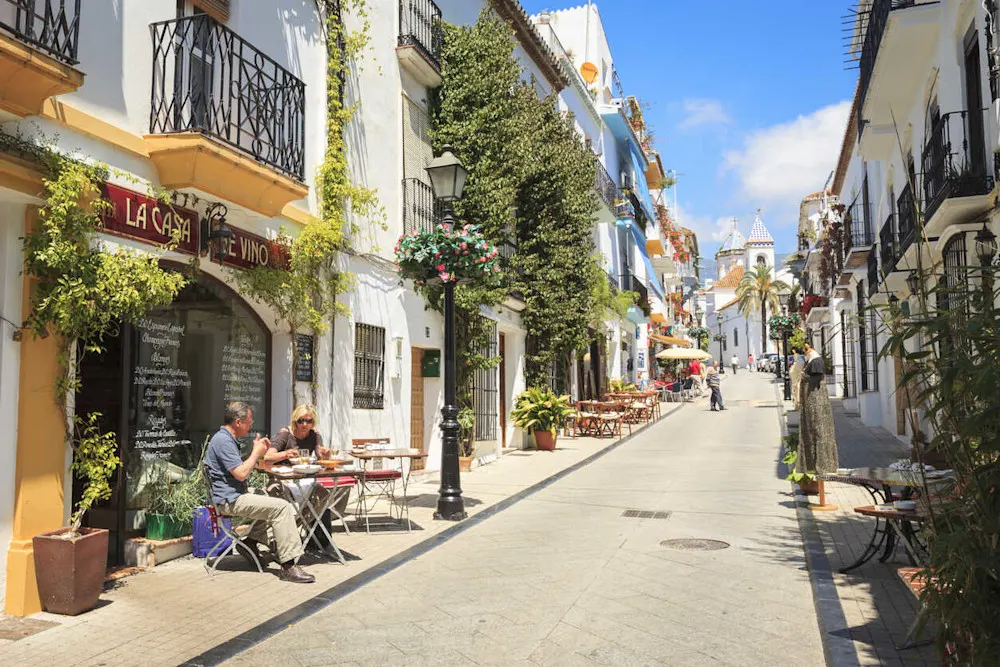
After exploring Andalusia's pueblos blancos, it's time to experience the energy of city life in Marbella. This essential Costa del Sol stop offers a mix of luxury, nightlife, beaches, and traditional charm. Plan for 3-4 nights to fully soak it all in, dedicating each day to a different experience—relaxing on the beach, shopping, adventuring in Puerto Banús, and exploring the Old Town.
While Marbella boasts many high-end sea-facing resorts, I recommend La Fonda Hotel in the Old Town, a beautifully restored 16th-century building that offers luxury with a twist.
Pick Your Beach For Your Vacation Backdrop
With over 300 days of sunshine a year, Marbella is a year-round beach destination. I love starting my days here with a walk along the coast, and with almost 19 miles of coastline, there's a beach for every mood.
For something quieter, I'd recommend Playa de los Monteros, where the dunes create a peaceful, laid-back atmosphere. But if you want to turn up the energy, head to La Sala for a lively beach club experience. Picture renting out a pool bed, chilling with some cocktails, and dancing to loud music—it's a fun scene.
If you're into active adventures, Marbella has plenty of water sports to try. Cabopino Beach is great for beginner surfers, or if you prefer something a bit more relaxed, grab a kayak or book a dolphin and whale-watching tour.
For golf lovers, Marbella is paradise. With more than 30 world-class courses, including La Quinta and Los Naranjos, it's one of Europe's best spots for a golfing holiday. For nature lovers, don't miss the Dunes of Artola at Cabopino. Walking through this natural monument is a peaceful escape, showcasing the untouched beauty of Marbella's coastline.
Get Your Free Spain Report Today!
Get Your Free Spain Report Today!
Learn more about the lower cost of living in Spain and other countries in our free daily postcard e-letter. Simply enter your email address below and we'll also send you a FREE REPORT — Live the Good Life in Sunny, Affordable Spain.

By submitting your email address, you will receive a free subscription to IL Postcards, Overseas Dream Home, The Untourist Daily and special offers from International Living and our affiliates. You can unsubscribe at any time, and we encourage you to read more about our Privacy Policy.
Discover the Old Town and Indulge in Mediterranean Cuisine
Of course, Marbella's Old Town is a must-see. I love getting lost here, especially around Plaza de la Iglesia—the heart of the historic district. Stop by Churrería Ramón in Plaza de los Naranjos for a quick snack. Their churros, served in a giant wheel with the freshest orange juice, are a delightful midday treat.
While paella is famously from Valencia, Marbella has an incredible culinary scene and is a great place to indulge in the rice dish. One of my favorite spots for paella is El Cortijo, where they offer four varieties. Pick from the Valenciana (with chicken, rabbit, beans, and veggies), the Mediterranean (with fresh seafood), the Arroz Negro (featuring black rice with squid), and the Vegetariana (with artichokes, asparagus, and beans).
If you're after a Michelin-star dining experience, Marbella has no shortage of options either—Nintai, Skina, BACK, and Messina are all outstanding. For something a bit more casual, I always stop by Jamon y Vino, a classic tapería where you can enjoy the best of Spain's artisanal offerings. Their matrimonio toast—a heavenly mix of Iberico ham and Manchego cheese on bread—is simple, but the flavors are out of this world.
From Bustling Markets to Local Boutiques
Now it's time to shop. Visit the Marbella Street Market on Mondays at Las Albarizas, where you can find everything from fresh veggies to unique accessories. Old Town Marbella has an endless variety of local shops to explore as well, so get lost among the charming streets and discover boutiques filled with artisan goods, handmade jewelry, and one-of-a-kind souvenirs that capture the spirit of the Costa del Sol.
One of my favorites is D·OLIVA, a specialty store where the friendly staff will guide you through tastings of their massive selection of locally-sourced olive oils—an authentic Spanish treat.
Dip Your Toe in the Glamorous Puerto Banús
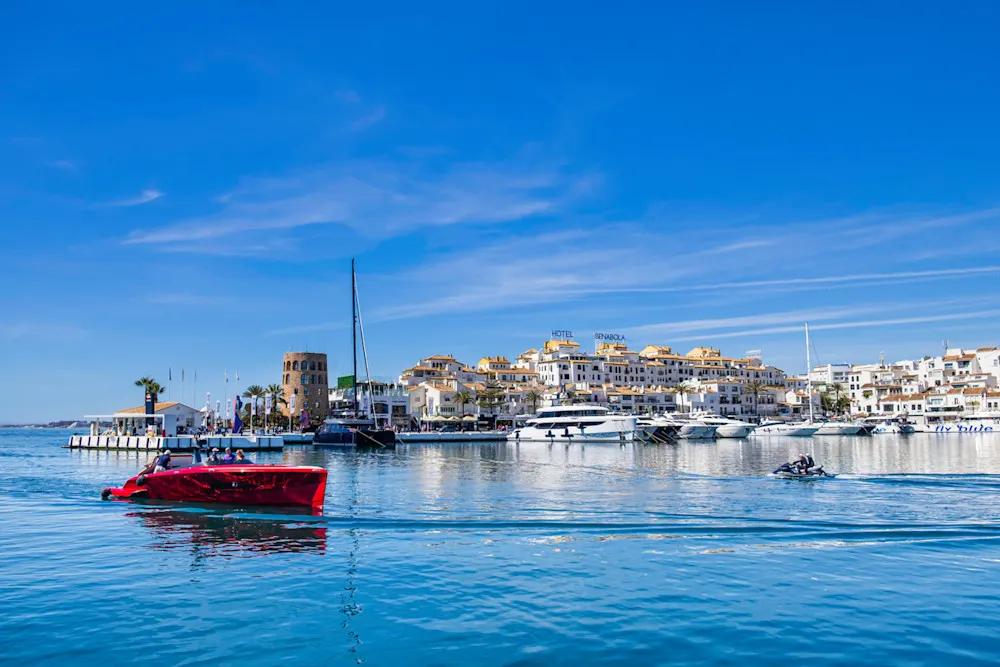
Just a 20-minute drive or a scenic ride on the Fly Blue Ferry, which runs hourly from 11:00 AM to 7:00 PM, Puerto Banús is a must-visit during your time in Marbella. Alternatively, you could make a night of it and stay in Puerto Banús. For a luxury experience, book a room at the Anfitrión Villas & Suites, rooms run from $450 in the low season to $650 in the high season. A more economical option is the Occidental Puerto Banús with rooms ranging from $150 to $250.
Puerto Banús is Marbella's glitzy neighbor, and it's a playground for the ultra-rich. The marina is lined with luxury yachts, sports cars, and designer stores like Dior and Hermès. Even if you're just window shopping like me, the vibe here is worth soaking in. For the best view of it all, head to Sky Lounge at the Benabola Hotel and grab a drink overlooking the port where you can see all the expensive yachts.
One of my favorite things about Puerto Banús is the Saturday Morning Market at Centro Plaza. From 8:00 AM to 3:00 PM, the area turns into a lively hub where you can browse everything from handmade jewelry to fresh produce. It's a great way to experience local culture. Afterwards, grab lunch at one of the many waterfront restaurants for Andalucian to high-end international cuisine ($25 to $75 per person).
Get Your Free Spain Report Today!
Get Your Free Spain Report Today!
Learn more about the lower cost of living in Spain and other countries in our free daily postcard e-letter. Simply enter your email address below and we'll also send you a FREE REPORT — Live the Good Life in Sunny, Affordable Spain.

By submitting your email address, you will receive a free subscription to IL Postcards, Overseas Dream Home, The Untourist Daily and special offers from International Living and our affiliates. You can unsubscribe at any time, and we encourage you to read more about our Privacy Policy.
When the sun goes down, Marbella's nightlife comes alive. For exclusive parties, Pangea in Puerto Banús is where the celebs and footballers go to hang out. But if you're after something more low-key, head back to Marbella to Astral for some fruity beach cocktails—personally, my preferred way to end a packed day.
Our Final Seaside Stop: Estepona
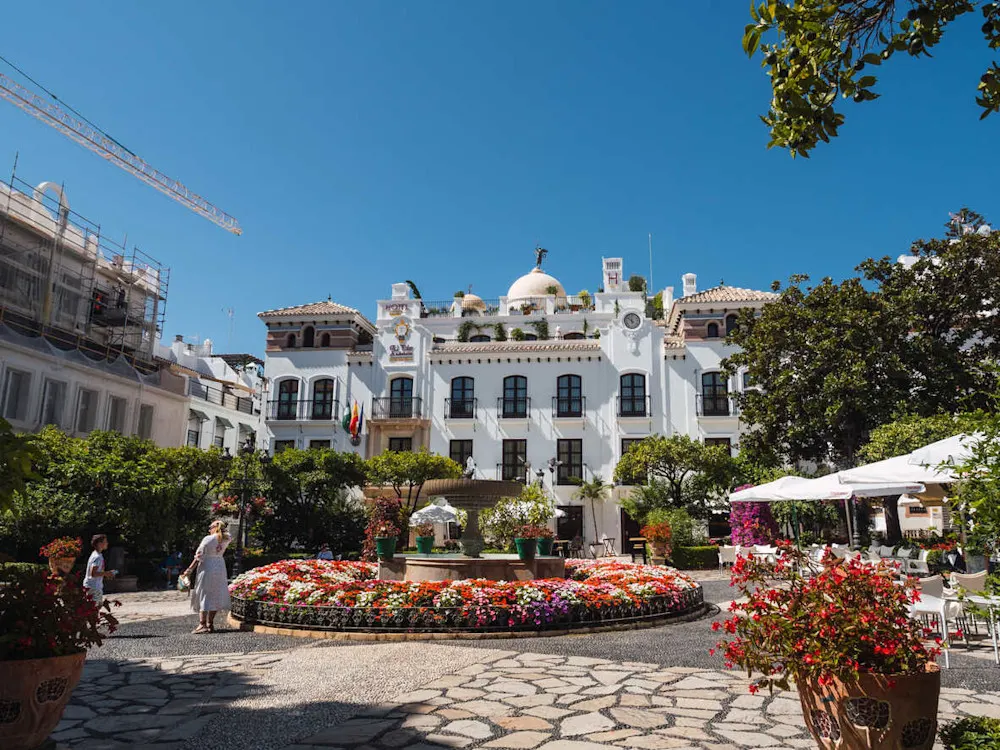
Just 30 minutes from Marbella, Estepona might surprise you with its blend of old-world characteristics and modern appeal. Once a quiet fishing village, it's now a fun town of around 70,000 people. Consider spending two nights in Estepona to fully enjoy all that it has to offer. For your stay, Hotel El Pilar Andalucía is a 4-star boutique gem in the heart of town, just steps from the coastline and the historic center, offering a perfect mix of beachside serenity and local culture.
Frozen in Time in the Sunshine
Start your day with a leisurely stroll through Estepona's Old Town, wandering through narrow alleys like Calle San Antonio and Calle Sirena that feel frozen in time. You can either wander aimlessly and discover hidden gems on your own (my favorite way to travel) or stop by the tourism office to grab a map that highlights the town's most quaint streets. Eventually, all roads lead to Plaza de las Flores, a delightful square dotted with cafes and orange trees, where Casa de las Tejerinas houses the tourist office and a gallery featuring local artists.
Estepona is famous for its Ruta de los Murales, or the Mural Route, which has an impressive collection of over 60 large murals. One of my personal favorites is “La Caída” by Vyacheslav Gunin. If you're into street art, you could easily spend an afternoon walking around town, discovering these public treasures.
For lunch, why not try salmorejo at Restaurante Taberna Diez? While gazpacho might be more familiar, salmorejo is a must-try dish from the city of Córdoba (a few hours from Estepona). This cold, creamy, tomato-based soup is made with bread, giving it a thicker texture than gazpacho. It's typically topped with hard-boiled eggs and diced ham. After lunch, walk through Plaza del Reloj to see the Clock Tower, the last standing piece of a 15th-century church destroyed by an earthquake in 1755.
Get Your Free Spain Report Today!
Get Your Free Spain Report Today!
Learn more about the lower cost of living in Spain and other countries in our free daily postcard e-letter. Simply enter your email address below and we'll also send you a FREE REPORT — Live the Good Life in Sunny, Affordable Spain.

By submitting your email address, you will receive a free subscription to IL Postcards, Overseas Dream Home, The Untourist Daily and special offers from International Living and our affiliates. You can unsubscribe at any time, and we encourage you to read more about our Privacy Policy.
As the day cools down, take a sunset stroll along Estepona's beach promenade. The views of the sea are stunning, and the path has sculptures and inviting beach bars, or chiringuitos, small beach bars. Stop at any of them for a cocktail or some fresh seafood while enjoying the breeze. If you're up for it, Madubar is a great restaurant to unwind after a day of adventures. It offers a cozy atmosphere with fresh, healthy dishes, including plenty of vegan options—which, at this point, might be a nice change of pace from your seafood tour of Costa del Sol.
A Day of Markets, Heritage, and Scenery
If you happen to be in Estepona on a Wednesday, you're in luck! The town hosts one of the largest markets in Andalusia from 9:30 AM to 2:00 PM at Parque De Las Mesas. There is also a market on Sunday at the port, although it's smaller and focuses more on jewelry, clothing, and leather goods. If you're feeling active afterwards, Playa Cristo is a short walk from the port—perfect for a quick dip!
For a slice of history, visit the Ruins of Castle San Luis, which date back to the 16th century. While much of the castle was destroyed, the remains offer a glimpse into Estepona's Medieval past. Nearby, you'll find Parroquia Nuestra Señora De Los Remedios, the oldest church in town, built in the 18th century. Its history is tied to the Franciscan Friars, who lived here until 1835.
Get Your Free Spain Report Today!
Get Your Free Spain Report Today!
Learn more about the lower cost of living in Spain and other countries in our free daily postcard e-letter. Simply enter your email address below and we'll also send you a FREE REPORT — Live the Good Life in Sunny, Affordable Spain.

By submitting your email address, you will receive a free subscription to IL Postcards, Overseas Dream Home, The Untourist Daily and special offers from International Living and our affiliates. You can unsubscribe at any time, and we encourage you to read more about our Privacy Policy.
Once you've had your fill of history, make your way to El Orquidario de Estepona. This Orchid House feels like a tropical oasis, home to 1,300 species of orchids from around the world. Entry is only 3 euros per adult and 1 euro for children.
Before wrapping up your time in Estepona, take in the views from Estepona Lighthouse, built in the 19th century. The views stretch all the way to Gibraltar on a clear day.
For dinner, pick up some picnic supplies from the Mercado de Abastos. You can then enjoy a simple meal on La Rada Beach, watching the waves roll in as the sun sets on another dreamy day in Estepona.
Journeying Inland: Two Idyllic Mountain Towns

Genalguacil: Get Lost (And Replenished) in Nature
Tucked in the heart of the southern Ronda Mountains, Genalguacil is a refreshing change of pace. This Andalusian village will be your peaceful escape with its breathtaking natural landscapes.
On your drive up the mountain to Genalguacil from Estepona, take a scenic drive through the Peñas Blancas mountain, pass and make a stop at El Charco Azul. This is a crystal-clear river pool where you can stop for a refreshing dip.
Once you arrive in Genalguacil, explore the area's natural surroundings. Hit the Los Saucillos 5.0-km trail, which is a moderate loop hike that offers amazing views of the mountainous landscape. The route winds through a Mediterranean forest filled with chestnut, walnut, and cherry trees, especially picturesque in the fall months.
For lunch, make your way to Venta de Las Cruces. Don't miss the chance to try their croquetas, a staple in Spanish cuisine. These crispy and creamy bites are filled with savory ingredients like jamón, chicken, or even codfish—the ideal comfort food to refuel after your hike.
Get Your Free Spain Report Today!
Get Your Free Spain Report Today!
Learn more about the lower cost of living in Spain and other countries in our free daily postcard e-letter. Simply enter your email address below and we'll also send you a FREE REPORT — Live the Good Life in Sunny, Affordable Spain.

By submitting your email address, you will receive a free subscription to IL Postcards, Overseas Dream Home, The Untourist Daily and special offers from International Living and our affiliates. You can unsubscribe at any time, and we encourage you to read more about our Privacy Policy.
Pay a visit to the Church of San Pedro Mártir de Verona. Although reconstructed in the 18th century, this church has historical roots dating back to the mid-16th century. Marvel at its architecture and bask in the serene atmosphere.
Unwind from your long day as the evening unfolds, perhaps sipping a glass of local wine from Pub Cabry. The spot has a chalkboard menu for fresh daily specials which are delicious and affordable. If you're a wine enthusiast, don't miss the chance to try the mosto blanco, a local specialty.
Although hotel options are limited, you'll find holiday homes offering beautiful views and a cozy atmosphere to get a restful night.
Ronda: The Perfect Place to Roam
Perched high above the El Tajo Gorge, the town of Ronda is, simply put, captivating. Famous for its Puente Nuevo, this ancient town is a treasure trove. Ernest Hemingway, who found inspiration in its gorgeous landscapes and rich bullfighting culture, once described it as the perfect backdrop for romance.
Begin your day by heading to Ronda's most iconic landmark: the Puente Nuevo bridge, which was built in 1759. This architectural marvel spans the deep El Tajo gorge, offering jaw-dropping views of the Guadalevín River below. Don't forget to pause at the Aldehuela viewpoint for photos!
Next up is a visit to Ronda's Arab Baths, which pay homage to the city's Moorish heritage. When I visited them, I couldn't help but marvel at the ingenious hydraulic systems that powered these ancient baths. The architecture, with its star-shaped vents, reminds me of the Alhambra in Granada.
Next on the itinerary is the Casa del Rey Moro, or House of the Moorish King. This stunning 18th-century building features lush gardens, a neo-Mudejar-style house, and a fascinating Muslim-era water mine. You will discover rooms filled with history, including the legendary Room of Secrets, where whispers carry across the dome like magic.
A key historical site in Ronda is the Plaza de Toros, considered the birthplace of modern bullfighting, with the tradition shifting from horseback to on-foot here. A visit to Spain's oldest bullring, dating back to 1785, offers a snapshot into Ronda's cultural heritage. The bullring also houses a museum where you can explore the history of the site and its role in Spanish tradition. Otherwise, you could opt to have a drink on the rooftop of the neighboring Hotel Catalonia, which offers a spectacular view of the ring.
Finally, it's time to treat yourself to your dinner reservation at Tropicana, where fine-dining Spanish classics are served up. One dish you can't miss is ajoblanco, a refreshing cold soup native to Granada and Malaga. This delightful dish is made of bread, crushed almonds, garlic, water, olive oil, salt, and vinegar and is garnished with sweet grapes or slices of melon.
After a memorable day, retreat to the Parador de Ronda for a restful night. This hotel is part of a chain that features restored castles and historic properties across Spain. Located next to Puente Nuevo, the Parador has stunning views. Enjoy a nightcap on the terrace as you take in the gorge, letting the enchantment of Ronda wash over you.
Caminito del Rey: New Heights of Malaga Province
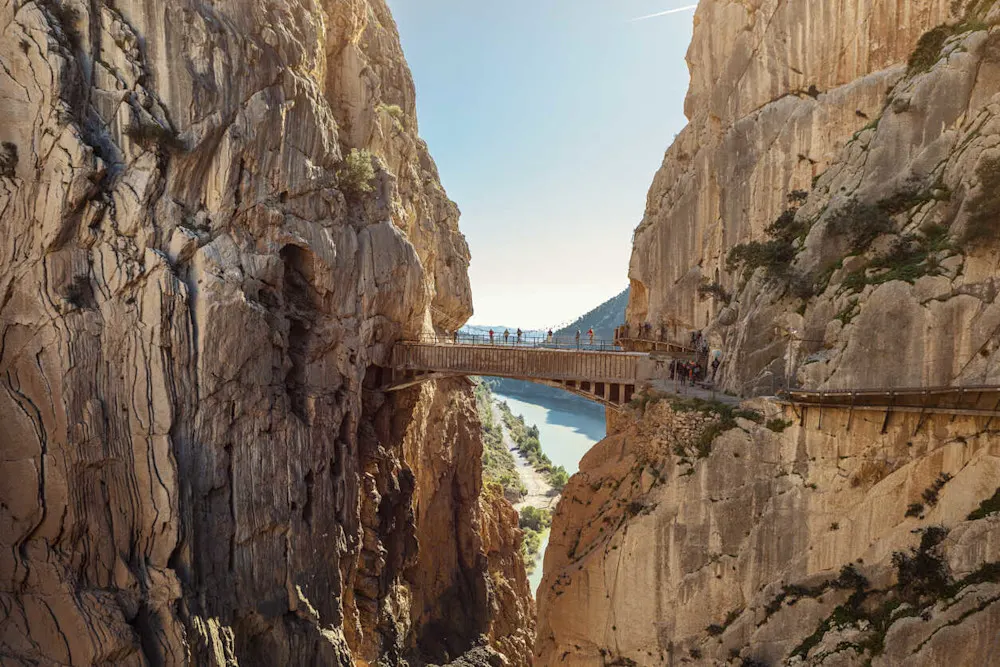
After soaking up the charm of Ronda, I highly recommend taking the hour-long drive to Caminito del Rey for a final adventure before heading back to Malaga. This breathtaking walkway, suspended 100 meters above the gorge, clings to the rocky face of Desfiladero de los Gaitanes. When I first set out to cross this myself, I felt a combination of excitement and nerves taking in the jaw-dropping views! But don't worry—the path is very safe.
Before diving into your adventure, be sure to secure your tickets on the official website. Caminito del Rey stretches nearly 5 miles and operates as a one-way route, meaning you'll need to catch the shuttle bus back to your car. It conveniently connects the two access points at Ardales to the north and Álora to the south.
Get Your Free Spain Report Today!
Get Your Free Spain Report Today!
Learn more about the lower cost of living in Spain and other countries in our free daily postcard e-letter. Simply enter your email address below and we'll also send you a FREE REPORT — Live the Good Life in Sunny, Affordable Spain.

By submitting your email address, you will receive a free subscription to IL Postcards, Overseas Dream Home, The Untourist Daily and special offers from International Living and our affiliates. You can unsubscribe at any time, and we encourage you to read more about our Privacy Policy.
Don't forget to pack plenty of water, sunscreen, and some snacks for this 3-4 hour walk. Also, keep in mind that once you're on the walkway, there are no toilets or garbage bins, so be sure to carry out any trash you bring along.
One of my favorite moments was crossing the suspension bridge at the end; the rush of adrenaline was exhilarating! The experience is less strenuous than a traditional hike since there isn't much elevation gain, but trust me, your heart will be racing at various points along the way.
A Home for Everyone
As I reflect on my time in Malaga, I find it hard to believe how my journey has unfolded. Five years ago, I never imagined I would call Andalusia home. Now, after discovering every corner of the province, I can confidently say I've fallen in love. The province has an enticing mix of history, culture, and striking scenery, and it blends city life with nature escapes. Truly, it's a place with a home for everyone.
I hope my experiences inspire you to explore the beauty of Malaga Province. You may just uncover a piece of the world and yourself in this magical corner of Spain.
Editor’s Note: This guide first appeared in International Living’s Untourist Dispatch—exclusive travel insights reserved for our IL Alliance Members. If you prefer to travel like an insider, avoiding the crowds and uncovering authentic experiences, this is for you. Learn more about becoming an Untourist here.
Get Your Free Spain Report Today!
Get Your Free Spain Report Today!
Learn more about the lower cost of living in Spain and other countries in our free daily postcard e-letter. Simply enter your email address below and we'll also send you a FREE REPORT — Live the Good Life in Sunny, Affordable Spain.

By submitting your email address, you will receive a free subscription to IL Postcards, Overseas Dream Home, The Untourist Daily and special offers from International Living and our affiliates. You can unsubscribe at any time, and we encourage you to read more about our Privacy Policy.
